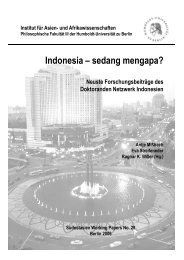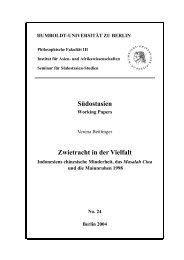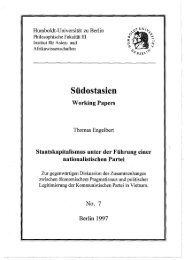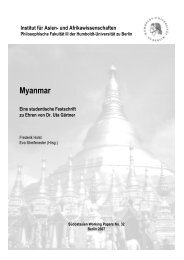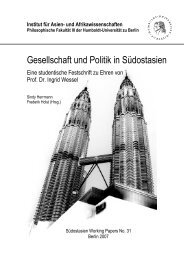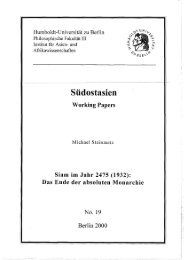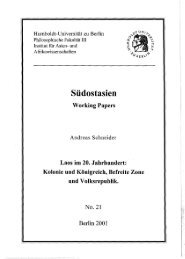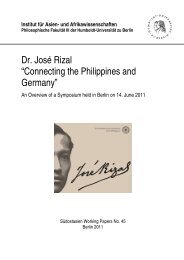groups were uniting against Suharto. It was linked to a general government campaign to denounceChinese, Christians, and pro-democracy regime opponents, blaming them for the economic crisis andinstability of the country.When Suharto stepped down on 29 May 1998, this struggle between conservative Islam and prodemocracyforces continued. Habibie’s presidency appeared to mark the elevation of Islam to the seatof national state power, since he had long served as chairman of ICMI, the patron and promoter of abroad variety of modernist Muslim activists seeking patronage and protection from the state. JohnSidel observed that “never before had forces favouring the so-called Islamization of Indonesian stateand society enjoyed such proximity to power”. 56 However, in the elections of June 1999, the fiction ofa united Muslim population universally represented by Habibie and allied forces proved to be an illusionin view of the strong gains by non-Islamist parties among Muslim and non-Muslim voters alike.The vote was clearly won by Megawati Soekarnoputri’s Indonesian Democratic Party of Struggle(PDIP) (34%) that is known for its Soekarnoist lineage, its secular-nationalist, ecumenical, and syncretistorientation, and its sizeable non-Muslim constituencies and membership. 57 More than one thirdof the members of parliament elected via the PDIP were non-Muslims, mostly Protestants, and virtuallynone of its Muslim MPs claimed a background of Islamic education or associational activity. 58Thus, the claims of universal representation made by conservative Islamist parties were poorlyreceived even among the broad mass of the Muslim population.Although Megawati’s party had won the vote, with the help of Islamic parties in Parliament, Wahidbecame president. But he was quick to remove or marginalise ministers associated with the variousMuslim parties and centralized power in the hands of NU associates, liberal Muslim and Christianpoliticians. 59 He particularly rejected any Muslim leaders’ efforts to rally public support for jihad inMaluku. Thus, those political leaders who had publicly rejoiced at the election of a prominent Muslimfigure to the presidency soon spoke in terms of Wahid’s betrayal of their trust and support and beganconspiring to affect the early demise of his presidency. 60 After a transitional administration dominatedby modernist Muslims protective of Islamist groups, Indonesia was ruled by a president identified withIndonesian traditionalist Islam liberalism, and accommodation of Christians.In conclusion, the violence in Maluku broke out against a national background of transition strugglebetween Muslim moderates and secularist versus Islamists and supporters of the old regime. The latterused religious framings, particularly the anti-Christian discourse, to discredit the Wahid government.Security forces were in a weakened position and struggled to ensure their political influence bydemonstrating their viability for the unity and stability of Indonesia, and also profited financially formunrest and violence. Consequently, there existed a fraction in Jakarta for whom violence in Malukualong religious lines appeared to have been profitable.Analysis: The Outbreak of Collective Violence in Maluku, 1999Maluku before the Outbreak of ViolenceMaluku is no homogenous region but consists of many islands, hundreds of communities and dozensof regional power centres. During the 1990s, religious patronage structures and segregation in every-5657585960Sidel, Riots, Progroms, Jihad, 132.Sidel, Riots, Progroms, Jihad.Sidel, Riots, Progroms, Jihad.Sidel, Riots, Progroms, Jihad, 211.Sidel, Riots, Progroms, Jihad, 210.22
day life were eroding. Ethnographic work on Maluku revealed a broad spectrum of diversity andchange in the religious beliefs and practices of those registered as Muslims and Christians in theprovince, with “conversion” a recent and ongoing process for many official believers, even well intothe 1990s. 61Patterns of migration to and within Maluku increased the diversity of religious practice. Ethnic tensionsgrew between both Christian and Muslim “natives” and immigrants over economic resources,property relations, village elections, and other issues. 62 “Muslims and Christians attended the samestate schools and universities, viewed the same television programs and movies, spoke the same linguafranca, and competed for the same opportunities”: trends toward social homogenization across the religiousdivide were evident. 63 In Ambon city, Protestant and Muslim neighbourhoods and houses ofworship were often found in close proximity, and Ambonese and migrants of different faiths mingledin the streets, the schools, the shops, and the offices of government. 64A Prelude to Violence: RumoursSeveral events preceded the outbreak of violence in Maluku that are widely assumed to have increasedtensions and hostilities. The first event was a rumour claiming that Maluku’s governor Saleh Latuconsina,himself a Muslim, had replaced “all 38” top civil servants in the province with Muslims. Thisaccusation of a one-sided policy appeared in an anonymous pamphlet in October 1998. 65 The governorvehemently affirmed the importance of a ‘balance’ between Protestant Christians and Muslims. 66 Hehad indeed, however, appointed a non-Protestant deputy governor and a non-Protestant provincial secretary.Thus, the Christian elite were removed from the three most powerful positions in the province. 67A second precursor at the end of 1998 was a meeting between Christian and Muslim communal leadersconvened by Latuconsina to alert them to guard against rumours of preparations for violence.Apparently, both sides went home and improved existing communication networks that largely reliedon churches and mosques connected by cellular and regular phones. 68 It remains unclear, however, towhat extent concrete warnings were given by the governor, and if the warnings were in regard torumours of attacks along religious lines, or to merely any kind of provocations between the communities.Student demonstrations against the military in Maluku may have increased the military’s aspirations toensure its domination in spite of the reformist agenda in Jakarta. From 16 to 18 November 1998, thousandsof students from the State University of Pattimura and Indonesian Christian University of theMoluccas held a series of demonstrations in Ambon decrying the dual-function of the military in frontof the District Military Command (Korem) of Pattimura. 69 Echoing the demands of the student-ledReformasi movement that forced Suharto to step down, the Ambonese student movement demanded an616263646566676869Sidel, Riots, Progroms, Jihad, 172.ICG (2002) Indonesia: The Search for Peace in Maluku. Asia Report N°31; Sidel, Riots, Progroms, Jihad, 174.Sidel, Riots, Progroms, Jihad, 174.Sidel, Riots, Progroms, Jihad, 191.Aditjondro, Guns, Pamphlets, Handie-Talkies.Van Klinken, Gerry (1999) What caused the Ambon violence? Perhaps not religious hatred but a corrupt civil servicesparked the bloodletting. In: Inside Indonesia 60, Oct-Dec 1999, 2.Van Klinken, What caused the Ambon Violence?, 2.Spyer, Fire without smoke, 7.Hasan, The radical Muslim discourse, 5.23
- Seite 1: Institut für Asien- und Afrikawiss
- Seite 4 und 5: SÜDOSTASIEN Working PapersISSN: 14
- Seite 7: VorwortBoryano Rickum und Eva Strei
- Seite 10 und 11: Theoretischer Zugang: Waldschutzkon
- Seite 12 und 13: Zum anderen ist ein weiteres Proble
- Seite 14 und 15: verbleiben die Landrechte beim Staa
- Seite 16 und 17: Dutschke, Michael/Wolf, Reinhard (2
- Seite 18 und 19: Many commentators perceive religion
- Seite 20 und 21: in Maluku was “basically not a re
- Seite 22 und 23: around Wahid’s NU, Megawati’s n
- Seite 26 und 27: end to the military’s political r
- Seite 28 und 29: January 20, the second day of viole
- Seite 30 und 31: When violence broke out in Maluku i
- Seite 32 und 33: children, were burned to death in t
- Seite 34 und 35: support of some elements in the arm
- Seite 36 und 37: interpretations and instrumentaliza
- Seite 38 und 39: Soei Liong, Liem (2002) It’s the
- Seite 40 und 41: Malaysia) war einer der wichtigsten
- Seite 42 und 43: Rückkehr und ReintegrationBereits
- Seite 44 und 45: NGO-Aktivist. Beide Kandidaten hatt
- Seite 46 und 47: Gastland. Darüber hinaus finden wi
- Seite 48 und 49: tergehen. Die Unterzeichner und Her
- Seite 51 und 52: 4 Remembering the dark: The Japanes
- Seite 53 und 54: le for the creation of certain iden
- Seite 55 und 56: Remembering and forgettingWith thes
- Seite 57 und 58: These fragments of the social memor
- Seite 59 und 60: The policy of remembrance’s diffe
- Seite 61 und 62: ConclusionThe task of this essay wa
- Seite 63 und 64: 5 Euro-asiatische Kindheit im Batav
- Seite 65 und 66: mal 25 Jahre einschließen. Im Zent
- Seite 67 und 68: erzogen, lässt sich nicht verallge
- Seite 69 und 70: Formale Voraussetzungen für eine e
- Seite 71 und 72: Frau. Eine Frau durfte nie Vormund
- Seite 73 und 74: Lebenshaltungskosten in Batavia war
- Seite 75 und 76:
Die fehlende Zuwendung des Vaters z
- Seite 77 und 78:
angelegt wurde, so z.B. zum Kirchga
- Seite 79 und 80:
ihrem Ehemann Joan van Hoorn an ihr
- Seite 81 und 82:
icht teilnehmen. Die Sorge um die K
- Seite 83 und 84:
asiatischen Familien und zum andere
- Seite 85 und 86:
Niederländer schickten ihre Kinder
- Seite 87 und 88:
Dies wurde allerdings verzeichnet,
- Seite 89 und 90:
Die meisten der Mischlingskinder wu
- Seite 91 und 92:
über das private Zusammenleben inn
- Seite 93 und 94:
Internetquellenhttp://hadith.al-isl
- Seite 95 und 96:
6 Freundschaft als soziale Praxis:i
- Seite 97 und 98:
laritäten und Überlagerungen mit
- Seite 99 und 100:
seiner Funktion auf individueller u
- Seite 101 und 102:
zunächst grob die wichtigsten sozi
- Seite 103 und 104:
Freundschaften „indonesisch“ od
- Seite 105 und 106:
Die Sphären lokalkulturell (javani
- Seite 107:
Haller Dieter (2001) Entwurf einer
- Seite 110 und 111:
Die Dia’ang betreiben als Bauern
- Seite 112 und 113:
tragen werden würde, die hier vorb
- Seite 114 und 115:
den traditionellen Schutz- und Gege
- Seite 117:
Über die AutorInnenNicola Borchard
- Seite 120:
22. Heinz Schütte (2003) Hundred F



